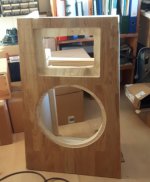I have also found BB hard to get a hold on. My last project (open baffle) I made materials from a combo of particle board and 15mm armored drywall/plasterboard. The armored drywall boards have fiberglass strands in it and is markedly stronger than regular drywall. It also has better sound dampening and is used where sound reduction thru the wall is one of the design goals.
The biggest issue was how to glue the drywall to the particle board, and I ended up using strips of sikaflex. I used parallel strips of sikaflex every inch or so, hoping to allow air to reach all the way into the middle of the boards.
Sikaflex is not cheap, and the armored drywall is 5x regular, but it all ended up cheaper than BB and the result is pretty good. The finish was paint on side and back, and the front got some oiled oak floor panel on it.
The biggest issue was how to glue the drywall to the particle board, and I ended up using strips of sikaflex. I used parallel strips of sikaflex every inch or so, hoping to allow air to reach all the way into the middle of the boards.
Sikaflex is not cheap, and the armored drywall is 5x regular, but it all ended up cheaper than BB and the result is pretty good. The finish was paint on side and back, and the front got some oiled oak floor panel on it.
here from after glue has dried. The sides and back are now marine yellow and the front is oiled (darker). The square cut out is so I can experiment with different drivers and positions. Using a 15 bass driver and have some Wild Burros on the way. At the moment I have some 6" Fostex. xo at ca 200Hz first order. Not finished...
edit. As you might see they are u-frame. almost 100cm high and ca 60cm wide, the u extending ca 25-30cm on both sides. The front tilts backward ca 5degrees.
edit. As you might see they are u-frame. almost 100cm high and ca 60cm wide, the u extending ca 25-30cm on both sides. The front tilts backward ca 5degrees.
Attachments
Last edited:
I like beech ply, a bit heavier than rest, 0.8g / cm3
Any well made, many plies composite will in general be best as each transition provides damping and more plies generally means greater stiffness. Higher density, unless it brings more stiffness, is not an asset we are looking for.
Nick McKinny liked poplat plywood. Baltic birch is generally a known quantity and often more available.
dave
Pass DIY Addict
Joined 2000
Paid Member
Not unlikely that the speaker in question is just completely saturated in stubbornness. 😀My dad built a big enclosure for a large 12" University Speakers coaxial driver (monaural Dynaco MKIV etc system) out of white pine in the very early 1960s sort of out of a stubborn effort based on everyone telling him it couldn't possibly work to use white pine. It is reinforced on the inside with cleats screwed in place with wax paper between the cabinet sides and the cleats, and the countersinking of the screws in the cleats is slightly oval-ized to allow for expansion and contraction. It was glued together with some non-premium ordinary adhesive. After my dad went 2-channel, he gave it to my cousins, several of whom carted it around as a musical instrument speaker to various gigs and basically gave it no mercy, in handling or in driving it to the limit with any amplifier they could get ahold of. Then it came back to me as a teen and I carted it around all through college, also giving it un-gentle treatment. And I still have it, and both the enclosure and the 12" driver still work great.
"Structural integrity level" = Effort/time*(material choice:knowhow²)/√willpower
That's just my own formula btw.
Last edited:
- Home
- Loudspeakers
- Full Range
- Next best wood after Baltic Birch?

